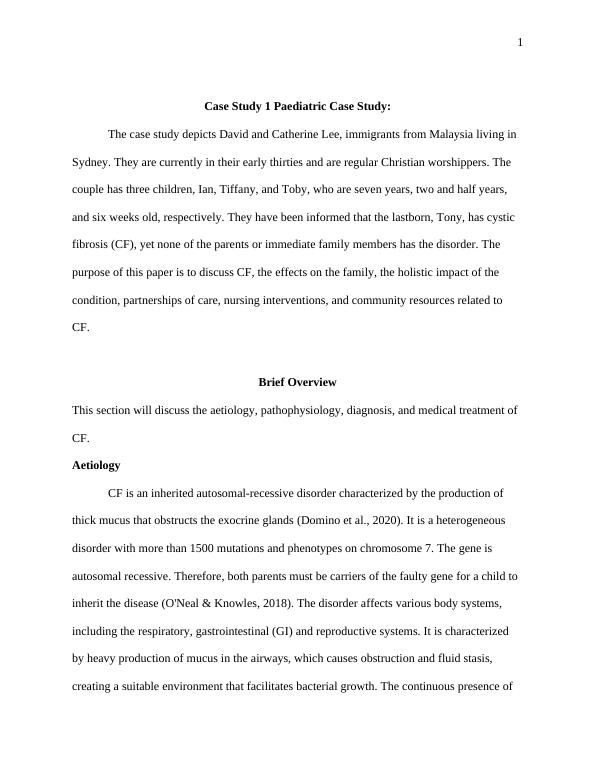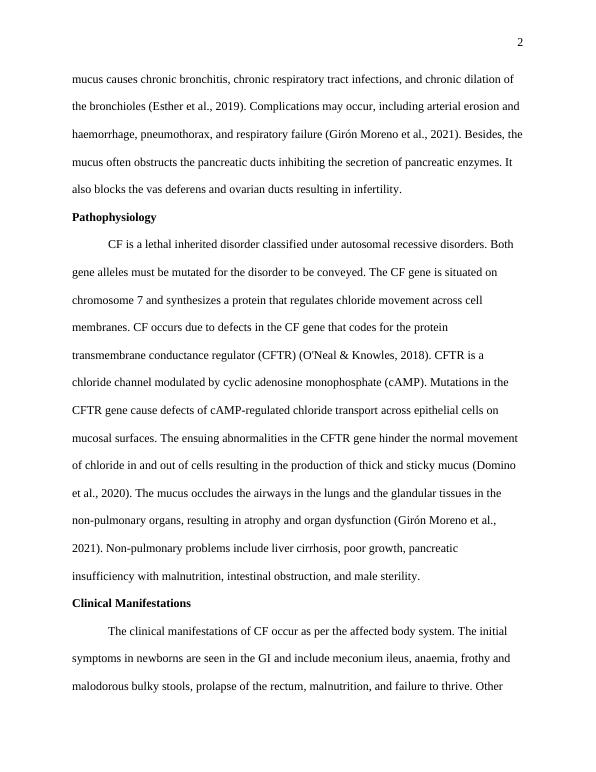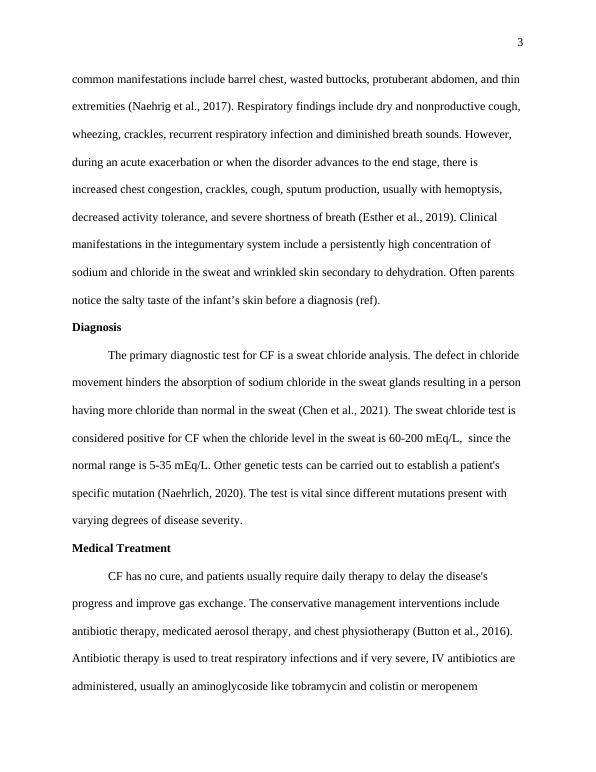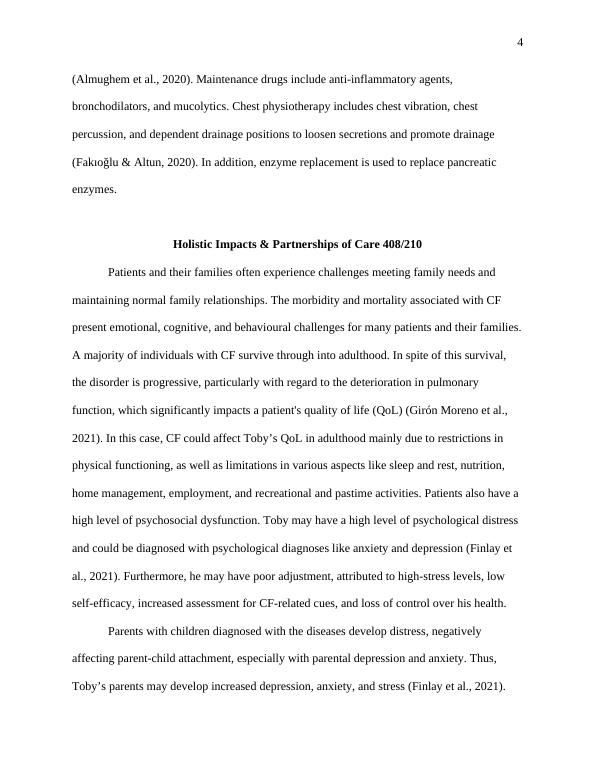Paediatric Case Study: Cystic Fibrosis and its Impact on the Family
Added on 2023-05-09
11 Pages3192 Words67 Views
1
Case Study 1 Paediatric Case Study:
The case study depicts David and Catherine Lee, immigrants from Malaysia living in
Sydney. They are currently in their early thirties and are regular Christian worshippers. The
couple has three children, Ian, Tiffany, and Toby, who are seven years, two and half years,
and six weeks old, respectively. They have been informed that the lastborn, Tony, has cystic
fibrosis (CF), yet none of the parents or immediate family members has the disorder. The
purpose of this paper is to discuss CF, the effects on the family, the holistic impact of the
condition, partnerships of care, nursing interventions, and community resources related to
CF.
Brief Overview
This section will discuss the aetiology, pathophysiology, diagnosis, and medical treatment of
CF.
Aetiology
CF is an inherited autosomal-recessive disorder characterized by the production of
thick mucus that obstructs the exocrine glands (Domino et al., 2020). It is a heterogeneous
disorder with more than 1500 mutations and phenotypes on chromosome 7. The gene is
autosomal recessive. Therefore, both parents must be carriers of the faulty gene for a child to
inherit the disease (O'Neal & Knowles, 2018). The disorder affects various body systems,
including the respiratory, gastrointestinal (GI) and reproductive systems. It is characterized
by heavy production of mucus in the airways, which causes obstruction and fluid stasis,
creating a suitable environment that facilitates bacterial growth. The continuous presence of
Case Study 1 Paediatric Case Study:
The case study depicts David and Catherine Lee, immigrants from Malaysia living in
Sydney. They are currently in their early thirties and are regular Christian worshippers. The
couple has three children, Ian, Tiffany, and Toby, who are seven years, two and half years,
and six weeks old, respectively. They have been informed that the lastborn, Tony, has cystic
fibrosis (CF), yet none of the parents or immediate family members has the disorder. The
purpose of this paper is to discuss CF, the effects on the family, the holistic impact of the
condition, partnerships of care, nursing interventions, and community resources related to
CF.
Brief Overview
This section will discuss the aetiology, pathophysiology, diagnosis, and medical treatment of
CF.
Aetiology
CF is an inherited autosomal-recessive disorder characterized by the production of
thick mucus that obstructs the exocrine glands (Domino et al., 2020). It is a heterogeneous
disorder with more than 1500 mutations and phenotypes on chromosome 7. The gene is
autosomal recessive. Therefore, both parents must be carriers of the faulty gene for a child to
inherit the disease (O'Neal & Knowles, 2018). The disorder affects various body systems,
including the respiratory, gastrointestinal (GI) and reproductive systems. It is characterized
by heavy production of mucus in the airways, which causes obstruction and fluid stasis,
creating a suitable environment that facilitates bacterial growth. The continuous presence of

2
mucus causes chronic bronchitis, chronic respiratory tract infections, and chronic dilation of
the bronchioles (Esther et al., 2019). Complications may occur, including arterial erosion and
haemorrhage, pneumothorax, and respiratory failure (Girón Moreno et al., 2021). Besides, the
mucus often obstructs the pancreatic ducts inhibiting the secretion of pancreatic enzymes. It
also blocks the vas deferens and ovarian ducts resulting in infertility.
Pathophysiology
CF is a lethal inherited disorder classified under autosomal recessive disorders. Both
gene alleles must be mutated for the disorder to be conveyed. The CF gene is situated on
chromosome 7 and synthesizes a protein that regulates chloride movement across cell
membranes. CF occurs due to defects in the CF gene that codes for the protein
transmembrane conductance regulator (CFTR) (O'Neal & Knowles, 2018). CFTR is a
chloride channel modulated by cyclic adenosine monophosphate (cAMP). Mutations in the
CFTR gene cause defects of cAMP-regulated chloride transport across epithelial cells on
mucosal surfaces. The ensuing abnormalities in the CFTR gene hinder the normal movement
of chloride in and out of cells resulting in the production of thick and sticky mucus (Domino
et al., 2020). The mucus occludes the airways in the lungs and the glandular tissues in the
non-pulmonary organs, resulting in atrophy and organ dysfunction (Girón Moreno et al.,
2021). Non-pulmonary problems include liver cirrhosis, poor growth, pancreatic
insufficiency with malnutrition, intestinal obstruction, and male sterility.
Clinical Manifestations
The clinical manifestations of CF occur as per the affected body system. The initial
symptoms in newborns are seen in the GI and include meconium ileus, anaemia, frothy and
malodorous bulky stools, prolapse of the rectum, malnutrition, and failure to thrive. Other
mucus causes chronic bronchitis, chronic respiratory tract infections, and chronic dilation of
the bronchioles (Esther et al., 2019). Complications may occur, including arterial erosion and
haemorrhage, pneumothorax, and respiratory failure (Girón Moreno et al., 2021). Besides, the
mucus often obstructs the pancreatic ducts inhibiting the secretion of pancreatic enzymes. It
also blocks the vas deferens and ovarian ducts resulting in infertility.
Pathophysiology
CF is a lethal inherited disorder classified under autosomal recessive disorders. Both
gene alleles must be mutated for the disorder to be conveyed. The CF gene is situated on
chromosome 7 and synthesizes a protein that regulates chloride movement across cell
membranes. CF occurs due to defects in the CF gene that codes for the protein
transmembrane conductance regulator (CFTR) (O'Neal & Knowles, 2018). CFTR is a
chloride channel modulated by cyclic adenosine monophosphate (cAMP). Mutations in the
CFTR gene cause defects of cAMP-regulated chloride transport across epithelial cells on
mucosal surfaces. The ensuing abnormalities in the CFTR gene hinder the normal movement
of chloride in and out of cells resulting in the production of thick and sticky mucus (Domino
et al., 2020). The mucus occludes the airways in the lungs and the glandular tissues in the
non-pulmonary organs, resulting in atrophy and organ dysfunction (Girón Moreno et al.,
2021). Non-pulmonary problems include liver cirrhosis, poor growth, pancreatic
insufficiency with malnutrition, intestinal obstruction, and male sterility.
Clinical Manifestations
The clinical manifestations of CF occur as per the affected body system. The initial
symptoms in newborns are seen in the GI and include meconium ileus, anaemia, frothy and
malodorous bulky stools, prolapse of the rectum, malnutrition, and failure to thrive. Other

3
common manifestations include barrel chest, wasted buttocks, protuberant abdomen, and thin
extremities (Naehrig et al., 2017). Respiratory findings include dry and nonproductive cough,
wheezing, crackles, recurrent respiratory infection and diminished breath sounds. However,
during an acute exacerbation or when the disorder advances to the end stage, there is
increased chest congestion, crackles, cough, sputum production, usually with hemoptysis,
decreased activity tolerance, and severe shortness of breath (Esther et al., 2019). Clinical
manifestations in the integumentary system include a persistently high concentration of
sodium and chloride in the sweat and wrinkled skin secondary to dehydration. Often parents
notice the salty taste of the infant’s skin before a diagnosis (ref).
Diagnosis
The primary diagnostic test for CF is a sweat chloride analysis. The defect in chloride
movement hinders the absorption of sodium chloride in the sweat glands resulting in a person
having more chloride than normal in the sweat (Chen et al., 2021). The sweat chloride test is
considered positive for CF when the chloride level in the sweat is 60-200 mEq/L, since the
normal range is 5-35 mEq/L. Other genetic tests can be carried out to establish a patient's
specific mutation (Naehrlich, 2020). The test is vital since different mutations present with
varying degrees of disease severity.
Medical Treatment
CF has no cure, and patients usually require daily therapy to delay the disease's
progress and improve gas exchange. The conservative management interventions include
antibiotic therapy, medicated aerosol therapy, and chest physiotherapy (Button et al., 2016).
Antibiotic therapy is used to treat respiratory infections and if very severe, IV antibiotics are
administered, usually an aminoglycoside like tobramycin and colistin or meropenem
common manifestations include barrel chest, wasted buttocks, protuberant abdomen, and thin
extremities (Naehrig et al., 2017). Respiratory findings include dry and nonproductive cough,
wheezing, crackles, recurrent respiratory infection and diminished breath sounds. However,
during an acute exacerbation or when the disorder advances to the end stage, there is
increased chest congestion, crackles, cough, sputum production, usually with hemoptysis,
decreased activity tolerance, and severe shortness of breath (Esther et al., 2019). Clinical
manifestations in the integumentary system include a persistently high concentration of
sodium and chloride in the sweat and wrinkled skin secondary to dehydration. Often parents
notice the salty taste of the infant’s skin before a diagnosis (ref).
Diagnosis
The primary diagnostic test for CF is a sweat chloride analysis. The defect in chloride
movement hinders the absorption of sodium chloride in the sweat glands resulting in a person
having more chloride than normal in the sweat (Chen et al., 2021). The sweat chloride test is
considered positive for CF when the chloride level in the sweat is 60-200 mEq/L, since the
normal range is 5-35 mEq/L. Other genetic tests can be carried out to establish a patient's
specific mutation (Naehrlich, 2020). The test is vital since different mutations present with
varying degrees of disease severity.
Medical Treatment
CF has no cure, and patients usually require daily therapy to delay the disease's
progress and improve gas exchange. The conservative management interventions include
antibiotic therapy, medicated aerosol therapy, and chest physiotherapy (Button et al., 2016).
Antibiotic therapy is used to treat respiratory infections and if very severe, IV antibiotics are
administered, usually an aminoglycoside like tobramycin and colistin or meropenem

4
(Almughem et al., 2020). Maintenance drugs include anti-inflammatory agents,
bronchodilators, and mucolytics. Chest physiotherapy includes chest vibration, chest
percussion, and dependent drainage positions to loosen secretions and promote drainage
(Fakıoğlu & Altun, 2020). In addition, enzyme replacement is used to replace pancreatic
enzymes.
Holistic Impacts & Partnerships of Care 408/210
Patients and their families often experience challenges meeting family needs and
maintaining normal family relationships. The morbidity and mortality associated with CF
present emotional, cognitive, and behavioural challenges for many patients and their families.
A majority of individuals with CF survive through into adulthood. In spite of this survival,
the disorder is progressive, particularly with regard to the deterioration in pulmonary
function, which significantly impacts a patient's quality of life (QoL) (Girón Moreno et al.,
2021). In this case, CF could affect Toby’s QoL in adulthood mainly due to restrictions in
physical functioning, as well as limitations in various aspects like sleep and rest, nutrition,
home management, employment, and recreational and pastime activities. Patients also have a
high level of psychosocial dysfunction. Toby may have a high level of psychological distress
and could be diagnosed with psychological diagnoses like anxiety and depression (Finlay et
al., 2021). Furthermore, he may have poor adjustment, attributed to high-stress levels, low
self-efficacy, increased assessment for CF-related cues, and loss of control over his health.
Parents with children diagnosed with the diseases develop distress, negatively
affecting parent-child attachment, especially with parental depression and anxiety. Thus,
Toby’s parents may develop increased depression, anxiety, and stress (Finlay et al., 2021).
(Almughem et al., 2020). Maintenance drugs include anti-inflammatory agents,
bronchodilators, and mucolytics. Chest physiotherapy includes chest vibration, chest
percussion, and dependent drainage positions to loosen secretions and promote drainage
(Fakıoğlu & Altun, 2020). In addition, enzyme replacement is used to replace pancreatic
enzymes.
Holistic Impacts & Partnerships of Care 408/210
Patients and their families often experience challenges meeting family needs and
maintaining normal family relationships. The morbidity and mortality associated with CF
present emotional, cognitive, and behavioural challenges for many patients and their families.
A majority of individuals with CF survive through into adulthood. In spite of this survival,
the disorder is progressive, particularly with regard to the deterioration in pulmonary
function, which significantly impacts a patient's quality of life (QoL) (Girón Moreno et al.,
2021). In this case, CF could affect Toby’s QoL in adulthood mainly due to restrictions in
physical functioning, as well as limitations in various aspects like sleep and rest, nutrition,
home management, employment, and recreational and pastime activities. Patients also have a
high level of psychosocial dysfunction. Toby may have a high level of psychological distress
and could be diagnosed with psychological diagnoses like anxiety and depression (Finlay et
al., 2021). Furthermore, he may have poor adjustment, attributed to high-stress levels, low
self-efficacy, increased assessment for CF-related cues, and loss of control over his health.
Parents with children diagnosed with the diseases develop distress, negatively
affecting parent-child attachment, especially with parental depression and anxiety. Thus,
Toby’s parents may develop increased depression, anxiety, and stress (Finlay et al., 2021).

End of preview
Want to access all the pages? Upload your documents or become a member.
Related Documents
Respiratory Cystic Fibrosis: Overview, Anatomy, Physiology, Treatment, and Patient Needslg...
|12
|1385
|87
Nursing and Case Study | Assignmentlg...
|5
|2139
|43
cystic Fibrosis Assignment PDFlg...
|8
|1489
|158
Pathophysiology of Cystic Fibrosis PDFlg...
|15
|3364
|568
Abdominal symptoms In Cystic Fibrosislg...
|5
|1029
|16
Assignment On Nursing Care Plan.lg...
|8
|1255
|12
